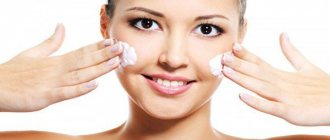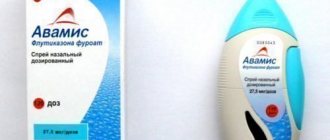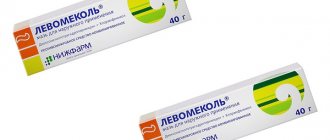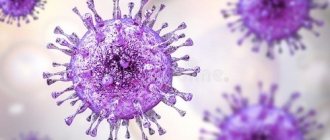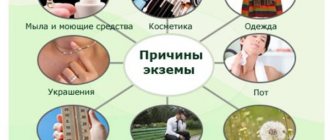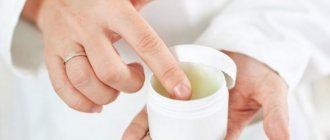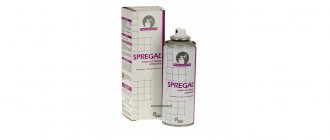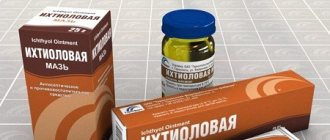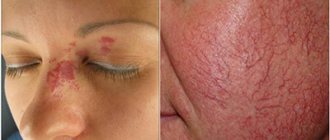Allergies on the face appear much more often than on other parts of the body, and the pathology is expressed by rashes, redness, swelling of the skin and mucous membranes, accompanied by severe itching and other unpleasant phenomena.
Every fifth person on the planet experiences pathological reactions. Facial allergies, in addition to aesthetic discomfort, indicate the presence of health problems.
Causes of allergies on the face
Remember! There are a large number of factors that contribute to the appearance of allergies, so sometimes it is necessary to use many methods to diagnose the pathology. Allergic reactions on the face are similar to a number of infectious diseases.
Allergy is the resistance of the immune system to the release of free histamine. Each person's skin reacts individually to the organic compound histamine, the biological substances of which act primarily as an irritant to the upper layer of the skin.
After a certain amount of time (it’s different for everyone), allergy symptoms appear. The symptoms of pseudoallergy are similar to the symptoms of true allergy, but the immune system is not involved.
Factors contributing to facial allergies:
- exposure to low temperatures, air, heat, ultraviolet rays;
- products with high concentrations of allergens;
- long-term use of potent medications - antibiotics, analgesics;
- pollen grains of highly allergenic plants, accumulation of mold spores, waste products of pets, dust;
- cosmetics whose composition is not suitable for some people due to their skin type;
- the influence of a severe psycho-emotional state, environmental pollution, genetic predisposition;
- abuse of deep cleansing of the facial skin - the upper layers of the skin become thinner, which leads to sensitization of the epidermis to the irritant.
Important! According to ICD-10, allergies on the face are assigned the number L-20-L-30 (Dermatitis and eczema).
Experts distinguish:
- Types of allergic reactions, that is, what contributed to the allergy - consumer products, medications, contact with an allergen and other reasons;
- Allergic manifestations - rash, peeling, itching, burning, redness, pimples on any part of the facial skin (forehead, cheeks, chin, bridge of the nose and even neck).
Allergic rashes on the face in an adult
Allergy ointments for children
In childhood, treatment of allergic diseases, including the use of ointments, should be prescribed and strictly monitored by a specialist. You can choose an effective remedy only after a thorough examination and identification of the cause of the allergy. Children's skin is very sensitive and thin. Therefore, it is recommended to use gentle ointments on a natural basis.
Effective ointments against allergies that can be used for children:
- Fenistil-gel is an antiallergic drug based on dimethindene maleate, which is prescribed to children from 1 month. Relieves itching, swelling, has a local anesthetic effect. It has proven itself in the treatment of diathesis and dermatitis. The gel begins to act within 20-40 minutes after application. The average cost of the drug is 390-420 rubles.
- Psilo-balm. Antiallergic agent based on diphenhydramine (1%). It has a pronounced antipruritic and anti-edematous effect. Has a slight analgesic and cooling effect. A tube of 20 g costs about 270 rubles.
- Wundehil - consists of several natural components (cinquefoil, sophora, yarrow, propolis). Has anti-inflammatory and bactericidal effects. Effective for weeping eczema, atopic dermatitis, urticaria. The average course of treatment with Wundehil is 7-10 days. A 15 g tube costs an average of 80 rubles.
- Gistan is a product based on hypoallergenic substances with the addition of the natural antihistamine betulin. The main active ingredient is dimethicone. The composition also includes herbal extracts and lily of the valley essential oil. Used for allergic manifestations on the face in children over 2 years old. The average cost of the cream is 180 rubles.
- Desitin is an ointment with zinc oxide. Used for children, starting from infancy, with diathesis, dermatitis, and other skin damage. Thanks to the vaseline-lanolin mixture in the composition, a protective film is formed on the skin, which prevents inflammation from spreading to other areas. Do not apply ointment to infected skin. A tube of 57 g costs 270-290 rubles.
- La-Cri is a preparation with plant extracts and natural oils, as well as panthenol, which has regenerating properties. The product delicately eliminates itching, swelling, and redness. Cost – 246 rubles.
Find out how gluten allergy manifests itself in adults and how to treat the pathology.
Read about the symptoms and treatment of allergic eye keratitis at this address.
In case of allergies on the face of newborns, Bepanten plus ointment is considered the safest. It contains dexpanthenol and the antiseptic chlorhexidine. The product promotes skin regeneration and protects it from infection. Easy to apply, non-stick. A tube of 30 costs an average of 430 rubles.
In severe cases of allergies, the doctor may prescribe hormonal ointment. But for children under 6 months of age, such drugs are strictly contraindicated. The choice of ointment depends on the age and condition of the child.
Classification of allergic reactions
Allergies in adults and children can occur for various reasons. At the moment when the immune system begins to fight the irritant, it is difficult to determine what contributed to the allergic reaction.
Allergic reactions are divided into:
- instantaneous - a dangerous type of allergy, characterized by the immediate onset of allergic symptoms. The reaction is observed several minutes to half an hour after interaction with the allergen;
- delayed - symptoms are noticed after a few hours - two, three days. A distinctive feature of the allergic reaction is pale, small rashes, usually with mild itching - a consequence of cumulative allergies.
Allergic acne on the face photo
Factors causing allergies
It has been experimentally established that certain factors provoke an allergic reaction in people. These include:
Food products: chocolate, strawberries, cocoa, seafood, citrus fruits, nuts, honey, milk (especially whole cow's, goat's), egg whites and some others. This is a short list of the most common food allergens.
The rule applies: the greater the amount of a “dangerous” product consumed, the stronger the body’s unwanted immune response.
In addition, during pregnancy, a woman’s sensitivity to certain nutrients increases. Doctors recommend using caution even those foods to which a woman has not previously had an inadequate reaction.
Pollen. For many people, allergies begin during the period of intense flowering of plants due to the fact that there is a lot of pollen in the air.
Medications. Most often these include antibiotics. Almost any chemical substance can cause allergic redness on the face.
Synthetic materials – washing powders, cosmetics. When choosing cosmetics, you need to pay attention to its composition: the safest products with a high content of natural ingredients.
Household dust and fluff can cause a lot of discomfort for allergy sufferers. Dust contains small particles of mites. They enter the nasal passages and cause a hypersensitivity reaction.
Animal fur. The danger is posed by foreign proteins that are contained in the saliva and in the upper layer of skin in animals.
This is not a complete list of substances that cause an inadequate response of the human immune system.
Allergy symptoms on the face
Allergic symptoms are directly related to the location and type of allergy.
Article on the topic: Diaper dermatitis in children - getting rid of it with medications and folk remedies
The main symptoms of allergies on the face:
- rashes of various types - spots, pustules, papules, blisters, scales, erosions;
- swelling, swelling of the face;
- redness.
Primary and secondary signs of an allergic reaction
At the initial stage of allergies on the skin of the face, the following are formed:
- pustules - small cavity formations with pus inside, which subsequently burst with further scarring of the tissue;
- papules are small red bumps, the size of which varies from 3 to 30 mm. Papules disappear without a trace after treatment;
- vesicles - a ball-shaped rash filled with liquid exudate - transparent or with blood impurities. Often formed during severe inflammatory process on the skin;
- blisters are defined, swollen rashes with liquid inside, they itch very much, and the skin of the face swells.
Allergy papules and pustules on the face
Secondary allergy symptoms are:
- scales - are formed due to peeling of the upper layer of skin, the result of healed papules, vesicles, pustules, as areas of dead epidermis are exfoliated. Grayish, white or yellowish crusts are localized on the eyebrows, ears, head, eyelids;
- scabs - noticed due to prolonged dermatitis. Yellowish or gray crusts form after the acute process has subsided from dried exudate;
- erosion - opened pustules and vesicles provoke erosive formations, which serve as open gates for the penetration of infections and bacteria.
In addition to various types of rashes on the face, the following allergic signs appear:
- facial flushing - often redness indicates a food allergy, the provocateurs of which are honey, nuts, chocolate, coffee, alcoholic drinks, citrus fruits. Redness appears on the cheeks, chin, neck, forehead;
- contact dermatitis - with allergies, the skin of the face begins to itch very much, redness and swelling of the epidermis are also possible;
- eczema is an allergic inflammation of the skin that occurs acutely, after which it usually becomes chronic. When an allergy occurs, the face turns red, swells, the skin becomes dry and begins to peel, various rashes form, and after them erosions are noticed;
- erythema - sometimes allergies provoke increased blood flow and dilation of capillaries, which is why you can notice red flat spots on the face that cannot be touched - they merge with the epidermis. The allergic reaction goes away with the elimination of the allergen;
- Quincke's edema - the allergy manifests itself with lightning speed, and the symptoms can be very diverse: from redness and swelling of the epidermis with severe itching to swelling of the mucous membranes - eyes, lips, eyelids. At the first symptoms, you must call an ambulance, otherwise swelling of the larynx, tongue, and upper palate may occur, which is accompanied by suffocation. This manifestation is called anaphylactic shock.
Attention! As for children, an allergy on the child’s face may appear when switching from breastfeeding to artificial feeding or with the introduction of complementary foods. If the mother is still breastfeeding, the baby develops allergic symptoms if the mother eats a highly allergenic product. Redness, itching, various rashes, crusts and scales form with contact dermatitis, eczema, and food allergies.
Allergies on the face around the mouth: causes and treatment
Article on the topic: Treatment methods for allergies to cats, relevant in [y] year
Medicines for adults
To effectively eliminate facial allergies in adults, non-hormonal and hormonal ointments can be used. Each of them has its own advantages and disadvantages. The choice of remedy is made by the doctor after a thorough examination and diagnosis.
Non-hormonal
The use of drugs does not affect the functionality of organs and systems, unlike hormonal drugs. But their effect is not observed immediately, but a cumulative effect occurs. Non-hormonal ointments are used only in combination with systemic antihistamines and restoratives.
The advantage of ointments without a hormonal component is the lack of addiction. The doctor selects the ointment based on the characteristics of the external manifestations of allergies on the face. Non-hormonal products are ideal for sensitive skin. They moisturize and soften it, relieve swelling and itching, and promote the regeneration of epidermal cells.
Review of effective non-hormonal allergy ointments for adult patients:
- Actovegin is a product containing hemoderivat of calf blood. Use twice a day for allergic reactions on the face for 7-10 days. Sometimes the ointment can cause an additional skin reaction to its components. Therefore, it is recommended to conduct a skin sensitivity test before use. A 20 g tube of 5% Actovegin ointment costs an average of 111 rubles.
- Solcoseryl is a natural remedy based on a concentrate from the blood of calves. The ointment accelerates reparative and regenerative processes, improves tissue metabolism. The average cost of a 20 g tube of ointment is 240 rubles.
- Radevit is an anti-inflammatory and antipruritic drug containing vitamins A, E, D2. The ointment normalizes the processes of keratinization of the skin and accelerates regeneration. Effective for allergic dermatoses, psoriasis, seborrheic dermatitis. Apply a thin layer to inflamed areas 2 times a day. A tube of 35 g costs about 380-430 rubles.
- Protopic is a Japanese ointment with tacrolimus as an active substance. Effectively eliminates itching, redness, softens the skin with atopic dermatitis. A 30 g tube will cost an average of 1,600 rubles.
The use of ointments with zinc is effective in eliminating external manifestations of allergies on the face. They relieve itching, peeling, and redness in a short time. In addition, zinc has an antibacterial and drying effect.
Effective ointments containing zinc:
In case of skin infection, the treatment regimen should be supplemented with antibiotic ointments:
Can there be an allergy to black tea and how to get rid of the disease? We have the answer!
Read about the symptoms of peanut allergy and the rules for treating the disease in this article.
Go to https://allergiinet.com/articles/immunoglobulin-e.html and find out what elevated immunoglobulin E in the blood means and how to correct the indicators.
Hormonal
They are prescribed in case of ineffectiveness of non-hormonal drugs and in case of severe manifestations of allergies. Unlike non-hormonal ointments, corticosteroids act quickly, eliminating allergy symptoms. It is forbidden to use the drugs for a long time, as they can cause thinning of the skin and aggravate the inflammatory process. Usually hormonal ointments are applied once a day. In rare cases, the number of applications is increased to 2.
According to the degree of activity, corticosteroids are divided into several groups:
- With low activity - used for minor allergic manifestations, use is also allowed for children under 2 years of age (Hydrocortisone, Prednisolone).
- With moderate activity - for more severe manifestations of allergies (Afloderm, Cinacort).
- Active action - used if you need to immediately relieve the symptoms of the disease, as well as for chronic allergic dermatoses (Apulein, Advantan, Elokom).
- Highly active ointments are prescribed only if drugs with lower activity (Dermovate) are ineffective.
Review of effective hormonal ointments for allergies:
- Advantan is a fatty ointment based on methylprednisolone aceponate. Can be used for children as it is considered safer than other steroid ointments. The cost of a 15 g tube is 530-540 rubles.
- Elokom is the active component of mometasone fuorate. An effective remedy for allergic dermatitis, psoriasis, eczema. Cost 360-370 rubles.
- Hydrocortisone – relieves itching, irritation, redness. Can be used in ophthalmology (eye ointment 3 g and 5 g). The price of a 10 g tube of 1% ointment is about 30 rubles.
- Lokoid is a cream based on hydrocortisone 17-butyrate. Used to treat neurodermatitis on the face and contact dermatitis. The product is easily absorbed and quickly relieves the symptoms of the disease. The cost of a 30 g tube is about 330 rubles.
Post Views: 2,343
Allergic symptoms taking into account the location of the lesion
In most cases, allergy symptoms appear for specific reasons. So, redness can be observed on the chin, cheeks, and forehead. But there are some peculiarities.
A rash usually does not appear in the eyes, but swelling, redness, lacrimation appears, and the mucous membrane becomes inflamed. The lips are also mucous membranes, like the eyes, so rashes are rare, and with an individual reaction on the inside of the lips, patients complain of blisters. Also, the lips become swollen, and the tingling sensation does not stop until the allergy subsides.
Allergies in the ears are manifested by severe redness and itching, which leads to flaking. Most often, an allergic reaction to the ears is a consequence of contact dermatitis or food allergies.
What to do if you have an allergy on the face, severe swelling
How does an allergy manifest itself?
Pimples on the skin are characteristic of urticaria, which belongs to the group of allergic dermatitis. The rash forms on different parts of the body and resembles a nettle burn. Atopic dermatitis manifests itself as spots, blisters, and crusts on the hands and cheeks. Previously, this disease was called “baby eczema.”
The reason for the body’s unusually strong reaction to the allergen is the interaction of antibodies with antigens in the body, the release of inflammatory mediators (histamine, serotonin).
Allergic blisters and pimples appear after eating certain foods, taking medications, or as a result of exposure of the skin to various toxic substances. The rash appears as a group of pink blisters or red spots. Most often, acne of allergic origin forms on the face, wrists, elbows, stomach and legs.
Allergy symptoms occur after exposure to irritants on the skin and mucous membranes, respiratory organs and digestive tract. The “first places” in the group of allergens are occupied by: nuts, chicken eggs, milk, seafood, citrus fruits. However, it is impossible to determine the cause of the disease by the appearance of pimples and blisters; it is necessary to donate blood for analysis and conduct allergy tests.
Allergy treatment
Important! Before treating facial allergies, you should consult your doctor. Self-therapy leads to irreversible consequences and complications.
Allergy treatment is provided depending on the speed of the reaction. Therapeutic methods for treating different types of allergies differ from each other. Fulminant and delayed types of allergies are treated differently.
Lightning type
Quincke's edema is a severe allergic reaction, the symptoms of which appear instantly and do not require delay or self-medication. You should immediately call a rescue team, and before the ambulance arrives, it is advisable to take an antihistamine to help relieve swelling.
In case of acute allergies, help will be provided by Suprastin, Tavegil, Diphenhydramine, Erius, Claritin, Cetrin, Fexadin and other medicines, at least one of them should preferably be stored in a home medicine cabinet.
Attention! Allergic Lyell's syndrome is characterized by an immediate course. Blisters quickly form on the skin of the face and other parts of the body, which burst, and the epidermis becomes covered with erosions. An allergic reaction is accompanied by high body temperature, and if you do not call an ambulance as soon as possible, death is possible.
Facial allergy Quincke's edema
Slow type
With a slow type of allergy, the processes occur sequentially and slowly. Typically, red spots appear on the face, which subsequently begin to itch and cause discomfort. The itching and redness are accompanied by a rash on the cheeks, chin and nasolabial triangle.
The sequence of actions for a patient suffering from a delayed type facial allergy:
- Determine the cause contributing to the irritation and allergic reaction. It is advisable to remember what you ate, drank, what medications you took recently, petted someone’s cat, came into contact with synthetic fabrics, etc.;
- Limit contact with the allergen - if you neglect this rule, the allergy will move from the acute stage to the chronic stage;
- Before visiting a doctor, wipe your face with a cotton pad soaked in a decoction of chamomile, calendula, string, and sage. The herbal decoction has an antiseptic and sedative effect;
- Make a compress using boric acid. Dilute 1 tsp. a glass of water and periodically apply moistened gauze to your face;
- Take an antihistamine - the sooner the substance begins to fight allergies, the faster the symptoms will go away;
- Visit an allergist or dermatologist, who will diagnose allergies using proven methods and then choose treatment tactics.
Note! Treatment depends on the severity of the allergic process.
Eczema on the face
After collecting anamnesis and tests, the doctor prescribes treatment for allergies on the face. Therapy is most often complex and may consist only of oral or local medications. The process of curing allergies consists of the following methods:
- restoration of the immune system;
- removing allergens from the body and purifying the blood;
- antihistamines.
Article on the topic: Allergy to perfume and perfume: symptoms and treatment
Medical recommendations for treating allergies:
- antihistamines in tablets, drops and syrups - children are prescribed antiallergic medications in syrups and drops, and children over 12 years of age and adults are prescribed tablets. New generation drugs Erius, Claritin, Xyzal and others are especially effective, but in acute conditions it is advisable to use first generation drugs - Suprastin, Tavegil, Diphenhydramine;
- non-hormonal and anti-inflammatory ointments and creams - Fenistil-gel, Skin-Cap, Bepanten;
- hormonal creams and ointments - if non-hormonal remedies do not cope with allergies on the face, corticosteroid drugs will help, which should be used with caution. It is not advisable for children to use hormonal medications, but for adults, Advantan, Elokom, Sinaflan will help;
- sorbents for cleansing the body of allergens - Enterosgel, Lactofiltrum, activated carbon;
- sedatives to calm and maintain the nervous system - Persen, tincture of valerian, motherwort.
Allergies on the face, neck and body
Treatment with folk remedies
It is important to know! Traditional methods of treatment will not cure allergies, but they help relieve symptoms, soothe and smooth the skin of the face.
Some people believe that doctors do not recommend treating allergies with non-standard medicine, but if the doctor is confident in the method, he will definitely prescribe recommendations.
Experts are confident that if you wash and smear your face with herbal mixtures of celandine, nettle, burdock, calendula, chamomile, dandelion and other medicinal plants, you can overcome allergic symptoms.
Here is one of the recipes. Requires 2 tbsp. l. dry small leaves of celandine and 2 tbsp. l. boiled water. Steam the medicinal herb, let it brew for about 4 hours, and then treat the affected areas of the face 2-3 times a day.
Most medicinal plants act as an anti-inflammatory, antiseptic and analgesic, and therefore relieve discomfort on the skin of the face.
Folk remedies for allergies
Prevention measures
- At the first signs of an allergy on the face, you should consult a doctor;
- Self-medication will not save you from allergies, but will only worsen the situation;
- If you are prone to allergic reactions, you should always keep an antihistamine at home;
- Following a hypoallergenic diet will relieve food allergy symptoms;
- Limit contact with the allergen.
Prevention
The basis of prevention is its careful selection. If you have a history of cases of the disease, you should carefully consider the choice of drugs. These should be the most hypoallergenic formulations, but even they will not guarantee the absence of a reaction.
- You should choose mainly those products that use natural ingredients; there are many organic cosmetics on the modern market. This category also includes products with a minimum amount of ingredients.
- Before applying to the skin, take a minimal amount and apply to a small area and monitor for any reaction that may occur. If itching, burning, redness and other unpleasant symptoms occur, it is better to avoid use.
- Perfumery should not be applied to open areas of the body at all; it is better to apply it to clothing, this not only reduces the risk of allergies, but also does not increase the immune response.
- All cosmetic products offered for purchase must be hermetically sealed. It is worth discarding the opened packaging, or the absence of signs of tightness and protective marks.
- You should not apply testers to your face or other areas without pre-treatment, or with reusable instruments. The bottles should be pre-treated, and the brushes should also be disinfected or sterilized.
- You cannot use other people’s cosmetics; it must be individual for each person, even if you live with him or are in close contact. Even close people may have an infection or skin microbiocenosis, which will subsequently cause an increased reaction of the body.
- Do not apply products with dirty hands or on previously untreated skin.
- If you have inflammatory diseases, after prolonged sun exposure, you should avoid exposing your skin to excess ingredients.
- People with hypersensitivity should use cosmetics from one line that is most suitable.
It is also recommended to seek advice from a specialist before making a choice, especially if there have already been cases of similar reactions in your anamnesis.
How to use hormonal ointments to treat acne?
Corticosteroid ointment Hydrocortisone 1% In the USA, it has long been considered among the vital and essential medicines. In Russia, since Soviet times, there has been a prejudice that hormonal drugs adversely affect the functions of the body. Corticosteroid substances in preparations for external use are not absorbed into the systemic circulation and are well tolerated.
The effect of a local hormonal agent for allergic rashes:
- quickly eliminates inflammation in the acne area;
- relieves redness and swelling of the skin;
- reduces burning, itching;
- helps healing.
Attention! Corticosteroid drugs are not used for acne, acne vulgaris, or rosacea.
The most popular hormonal ointments are Flucinar, Lokoid, Sinaflan, Advantan, Flucort, Elokom. The names are varied, but the drugs contain only one active ingredient from a short list of corticosteroids: mometasone, hydrocortisone, beclomethasone. They can cause skin atrophy, so you should follow the recommendations of your doctor and the manufacturer of the drug.
